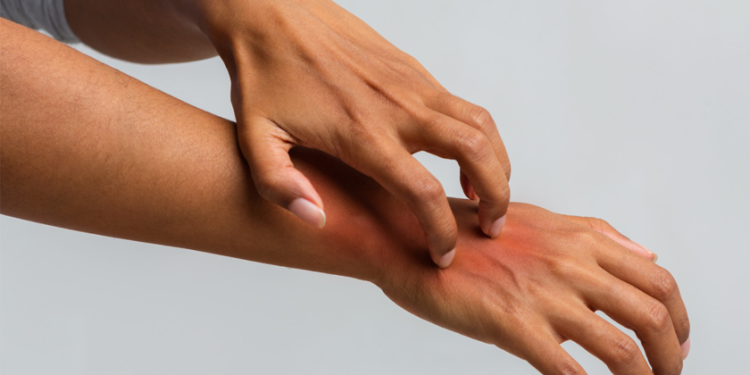What is Psoriasis?
Psoriasis is a chronic autoimmune disease that causes the overproduction of skin cells. The body’s immune system attacks healthy skin cells, causing them to grow and multiply at an accelerated rate. This results in the formation of raised, red patches covered with white or silver scales, which can be itchy and painful.
Psoriasis can occur on any part of the body, but is most commonly found on the scalp, elbows, knees, and lower back. While there is no cure for psoriasis, there are many treatment options available that can help to control the symptoms and improve the quality of life for those who suffer from this condition.
What are the Different Types of Psoriasis?
Plaque psoriasis. The most common form, plaque psoriasis causes dry, raised, red skin patches (lesions) covered with silvery scales. The plaques might be itchy or tender, and there may be few or many. They usually appear on elbows, knees, lower back and scalp.
Nail psoriasis. Psoriasis can affect fingernails and toenails, causing pitting, abnormal nail growth and discoloration. Psoriatic nails might loosen and separate from the nail bed (onycholysis). Severe cases may cause the nail to crumble.
Guttate psoriasis. Vesicles are painful and inconvenient, yet they can be easily treated. In most cases, the pain is severe. When a person touches something hot or has been in an environment where there is a lot of moisture, bacteria thrive, and this leads to formation of vesicles. They form on the trunk (especially), arms or legs as small, drop-shaped scaling patches.
Pustular psoriasis. Generalized pustular psoriasis, in which the skin lesions are large and widespread (generalized pustular psoriasis), or tiny and localized on the palms of hands or feet.
Psoriatic arthritis. Psoriatic arthritis is an autoimmune disease that causes inflamed, painful joints that are characteristic of arthritis. The symptoms of psoriasis can sometimes be the first or only manifestation or sign of psoriatic arthritis. Nail changes, on the other hand, may occur alone. Symptoms range from minor to severe, and psoriatic arthritis affects every joint in some cases. It may bring about stiffness and serious joint damage, with the most severe situations leading to permanent joint damage.
Erythrodermic psoriasis. Erythrodermic psoriasis, the least frequent form of psoriasis, can appear on your entire body with a red, flaking rash that may itch or burn.
Inverse psoriasis. This form of psoriasis affects the folds of the groin, buttocks, and breasts. Smooth red patches develop on skin when friction or sweating exacerbate inverse psoriasis. This sort of psoriasis can be caused by fungal infections.
What Causes Psoriasis?
The exact cause of psoriasis is not known, but it is thought to be the result of a combination of environmental and genetic factors. Certain triggers, such as stress, infection, or injury to the skin, can cause a flare-up of symptoms.
Who Gets Psoriasis?
Psoriasis is a relatively common condition that affects about 2% of the population. It can occur in people of any age but is most commonly diagnosed in adults between the ages of 30 and 50.
What Are the Symptoms of Psoriasis?
The symptoms of psoriasis can vary from person to person, but typically include red, scaly patches on the skin that are often itchy and painful. In some cases, psoriasis can also lead to joint pain, fatigue, and depression.
Psoriasis patches can appear a variety of ways, from mild dandruff-like scaling to severe eruptions that cover broad regions. The majority of people who suffer from psoriasis have problems with the lower back, elbows, knees, legs, soles of the feet, scalp, face and palms. Psoriasis has various phases: it flares for a few weeks or months before subsiding for an extended period or even going into remission.
How is Psoriasis Diagnosed?
There is no single test for diagnosing psoriasis, but a doctor will typically base their diagnosis on the appearance of the skin lesions and a review of the patient’s medical history. In some cases, a blood test or skin biopsy may be ordered to rule out other conditions.
How is Psoriasis Managed and Treated?
There is no cure for psoriasis, but there are many treatment options available that can help to control the symptoms and improve the quality of life for those who suffer from this condition. These treatments include topical medications, light therapy, and oral medications.
There are many things you can do to help manage your psoriasis, including:
- Using topical medications and/or light therapy as prescribed by your doctor
- Sticking to a healthy diet and exercise routine
- Avoiding known triggers
- Getting enough rest and stress relief
- Talking to other people with psoriasis about their experiences and strategies for managing the condition.
Conclusion
Psoriasis is a chronic autoimmune disease that affects 2% of the US population with no understanding of the cause. People who have Psoriasis can take steps to manage and treat Psoriasis. If you or someone you know has Psoriasis, make sure to share this article so they can cover the basics before going to see a doctor.


